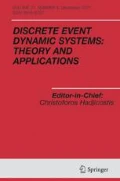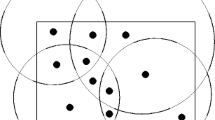Abstract
This paper discusses the problem of selecting a set of sensors of minimum cost that can be used for the synthesis of a supervisory controller. It is shown how this sensor selection problem is related to a type of directed graph st-cut problem that has not been previously discussed in the literature. Approximation algorithms to solve the sensor selection problem can be used to solve the graph cutting problem and vice-versa. Polynomial time algorithms to find good approximate solutions to either problem most likely do not exist (under certain complexity assumptions), but a time efficient approximation algorithm is shown that solves a special case of these problems. It is also shown how to convert the sensor selection problem into an integer programming problem.
Similar content being viewed by others
References
Arora S, Lund C (1997). Hardness of approximations. In: D S Hochbaum (ed) Algorithms for NP-Hard Problems. Boston, MA: PWS Publishing, pp 46–93.
Ausiello G, Crescenzi P, Gambosi G, Kahn V, Marchetti-Spaccamela A, Protasi M (1999). Complexity and Approximation Combinatorial Optimization Problems and Their Approximability Properties, Springer-Verlag, Berlin, Heidelberg.
Cassandras CG, Lafortune S (1999). Introduction to Discrete Event Systems. Boston, MA: Kluwer Academic Publishers.
Cho H (1990). Designing observation functions in supervisory control. In Proc. Korean Automatic Control Conference, pp 523–528.
Garey MR, Johnson DS (1979). Computers and Intractability: A Guide to the Theory of NP-Completeness. San Francisco, CA: W.H. Freeman.
Haji-Valizadeh A, Loparo KA (1996). Minimizing the cardinality of an events set for supervisors of discrete-event dynamical systems. IEEE Trans Automat Contr 41(11): 1579–1593.
Jiang S, Kumar R, Garcia HE (2003). Optimal sensor selection for discrete-event systems with partial observation. IEEE Trans Automat Contr 48(3):369–381.
Khuller S, Kortsarz G, Rohloff K (2004, September). Approximating the minimal sensor selection for supervisory control. In Proc. 7th Workshop on Discrete Event Systems, Reims, France, pp 85–90
Kortsarz G (2001). On the hardness of approximating spanners, Algorithmica, special Approx-98 issue, 30(3):432–450.
Lin F, Wonham WM (1988). On observability of discrete-event systems. Inf Sci 44:173–198.
Papadimitriou CH, Steiglitz K (1982). Combinatorial Optimization: Algorithms and Complexity. Prentice-Hall, Inc., Englewood Cliffs, NJ.
Ramadge PJ, Wonham WM (1987). Supervisory control of a class of discrete-event processes. SIAM J Control Optim 25(1):206–230.
Ramadge PJ, Wonham WM (1989). The control of discrete-event systems. Proc. IEEE 77(1):81–98.
Raz R (1998). A parallel repetition theorem. SIAM J Comput 27(3):763–803.
Rohloff K (2004). Computations on Distributed Discrete-Event Systems. PhD thesis, The University of Michigan: Ann Arbor. Available at http://www.eecs.umich.edu/umdes.
Rohloff K, van Schuppen JH (2004, December). Approximating the minimal-cost sensor-selection for discrete-event systems. Technical Report MASR0404, Centrum voor Wiskunde en Informatica (CWI), Amsterdam, the Netherlands.
Rohloff K, van Schuppen JH (2005). Approximating minimal communicated event sets for decentralized supervisory control. In Proc. of the 16th IFAC World Congress.
Rudie K, Willems JC (1995). The computational complexity of decentralized discrete-event control problems. IEEE Trans Automat Contr 40(7):1313–1318.
Tsitsiklis J (1989). On the control of discrete-event dynamical systems. MCCS Math Control Signals and Syst 2:95–107.
Vazirani V (2001). Approximation Algorithms. Springer-Verlag, Berlin, Heidelberg.
Yoo T-S, Lafortune S (2002). NP-completeness of sensor selection problems arising in partially-observed discrete-event systems. IEEE Trans Automat Contr 47(9):1495–1499.
Young S, Garg VK (1994, October). Optimal sensor and actuator choices for discrete event systems. In Proc. 31st Allerton Conference on Communication, Control, and Computing, pp 36.
Author information
Authors and Affiliations
Corresponding author
Rights and permissions
About this article
Cite this article
Rohloff, K.R., Khuller, S. & Kortsarz, G. Approximating the Minimal Sensor Selection for Supervisory Control. Discrete Event Dyn Syst 16, 143–170 (2006). https://doi.org/10.1007/s10626-006-6187-3
Published:
Issue Date:
DOI: https://doi.org/10.1007/s10626-006-6187-3




